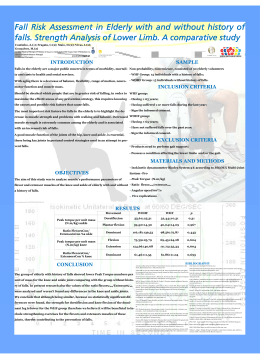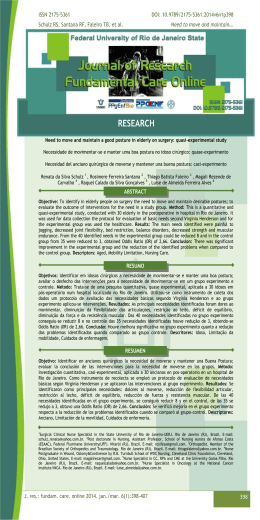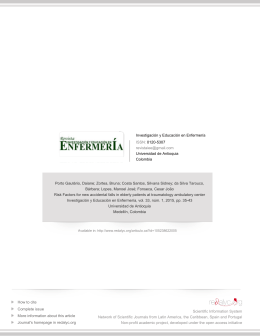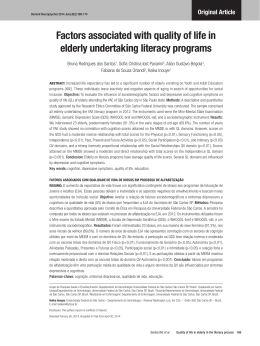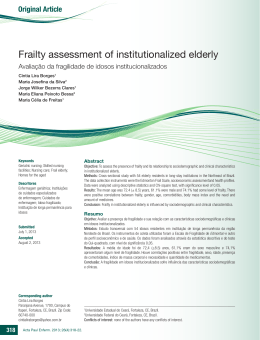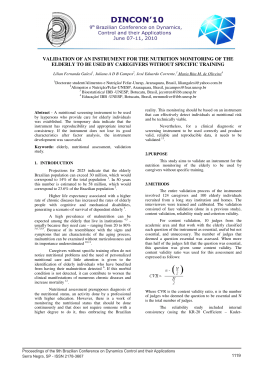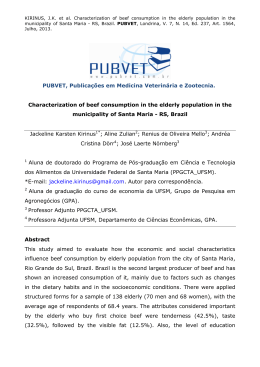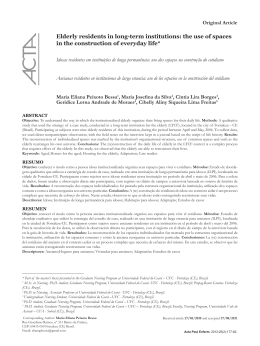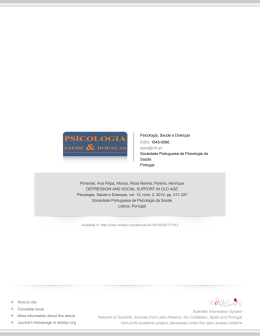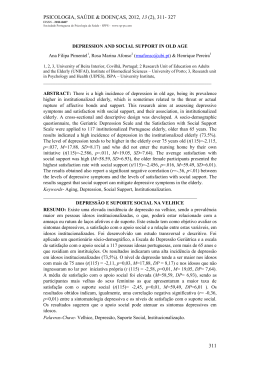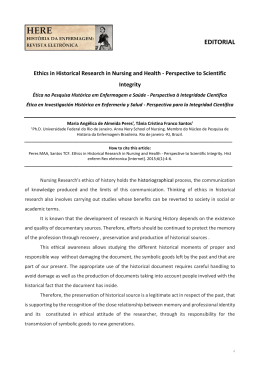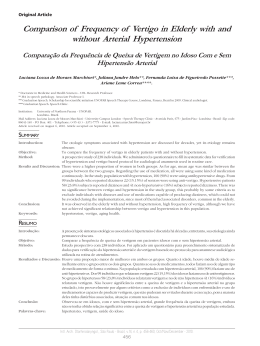Original article Risk Factors for new accidental falls in elderly patients at traumatology ambulatory center Daiane Porto Gautério1 Bruna Zortea2 Silvana Sidney Costa Santos3 Bárbara da Silva Tarouco4 Manoel José Lopes5 Cesar João Fonseca6 Risk factors for new accidental falls in elderly patients at Traumatology Ambulatory Center 1 RN, Ph.D. Candidate. Universidade Federal do Rio Grande –FURG-, Brazil. email: [email protected] 2 Nursing Undergraduate. FURG, Brazil. email: [email protected] 3 RN, Ph.D. FURG, Brazil. email: [email protected] 4 RN, Ph.D. FURG, Brazil. email: [email protected] 5 RN, Ph.D. Universidade de Évora, Portugal. email: [email protected] 6 RN, Ph.D. Candidate. Universidade de Évora, Portugal. email: [email protected] Article linked to research: Construction of instrument of data collection using the International Classification of Functioning, Disability and Health (ICF) and directed to the Nursing care to the elderly. Subventions: Conselho Nacional de Desenvolvimento Científico e Tecnológico, process n.123677/2012-2. Conflicts of interest: none. Receipt date: September 22, 2013. Approval date: November 4, 2014. How to cite this article: Gautério DP, Zortea B, Santos SSC, TaroucoBS, Lopes MJ, Fonseca CJ. Risk factors for new accidental falls in elderly patients at traumatology ambulatory center. Invest Educ Enferm. 2015; 33(1): 35-43 Objective. To identify the risks factors for new accidental falls in elderly patients attended in the Traumatology Ambulatory of a University hospital in Rio Grande do Sul, Brazil. Methodology. Quantitative study of the type of multiple cases. Performed at the traumatology ambulatory, amongst fifteen elders that attended the inclusion criteria: age of sixty or more; patient at the traumatology ambulatory because of a fall motivated by accident, oriented and in conditions of answer an interview of data collectors. The data collection was made between April and June, 2013, with the Elderly Nursing Core Set scale (Lopes & Fonseca). The data analysis was made by a descriptive structure, which helped identify the existence of relation patterns among the cases. Results. The risk factors for new accidental falls identified with larger incidence amongst the elders studied were: impaired balance (15/15), age above 65 (11/15), use of antihypertensive drugs (9/15), absence of non-slip material at home environment (7/15), in seven cases; rugs scattered at the floor of the house (6/15). Conclusion. The combination of intrinsic and extrinsic factors that include the environmental risks is considered a much more relevant cause to occur the new falls. The minimization of the home dangers, allied to the control of the elder intrinsic factors, may reduce the risks of causes. In that sense, is necessary that the nursing team make available more attention to the elderly assisted at the ambulatories, mainly those with sequelae due to fall accidents. Key words: aged; accidental falls; risk factors; nursing. Factores de riesgo para nuevas caídas accidentales en ancianos atendidos en un centro ambulatorio de traumatología Objetivo. Identificar los factores de riesgo para nuevas caídas accidentales en ancianos atendidos en un centro ambulatorio de traumatología de un hospital universitario en Rio Grande do Invest Educ Sul, Brasil. Metodología. Estudio cuantitativo del Enferm. tipo de 2013;31(3) serie de • 35 Daiane Porto Gautério • Bruna Zortea • Silvana Sidney Costa Santos • Bárbara da Silva Tarouco • Manoel José Lopes • Cesar João Fonseca casos, realizado en un centro ambulatorio de traumatología con 15 ancianos quienes cumplieron los criterios de inclusión: tener 60 años o más, con diagnóstico de caída accidental, estar orientado y en condiciones de responder los datos solicitados por los encuestadores. Se empleó el instrumento Elderly Nursing Core Set de (Lopes y Fonseca) para la toma de la información en 2013. El análisis de los datos se realizó con estadística descriptiva, la cual ayudó en la identificación de la existencia de patrones de relaciones entre los casos. Resultados. Los factores de riesgo para nuevas caídas accidentales identificados con mayor frecuencia en los ancianos investigados fueron: problemas en el equilibrio (15/15), edad por encima de 65 años (11/15), uso de agentes antihipertensivos (9/15), ausencia de material antideslizante en el ambiente doméstico (7/15), tapetes dispersos por el suelo de la casa. Conclusión. La combinación de factores intrínsecos e extrínsecos, que incluyen los riscos ambientales, es la asociación más relevante para la ocurrencia de nuevas caídas. En este sentido, es necesario que el equipo de enfermería haga énfasis en la educación sobre la reducción de los peligros domésticos, así como del control de los factores intrínsecos del anciano con el fin de disminuir el riesgo de nuevas caídas. Palabras clave: anciano; accidentes por caídas; factores de riesgo; enfermería. Riscos de novos acidentes por quedas em idosos atendidos em ambulatório de traumatologia Objetivo. Identificar os riscos de novos acidentes por quedas, em idosos, atendidos no ambulatório de traumatologia de um hospital universitário no Rio Grande do Sul, Brasil. Metodologia. Estudo quantitativo de tipo de casos múltiplos. Realizado no ambulatório de traumatologia, com quinze idosos que atenderam os critérios de inclusão: ter sessenta anos ou mais; estar em atendimento no ambulatório de traumatologia em decorrência de acidente por queda; estar orientado e em condições de responder e interagir com os coletadores de dados. A coleta de dados foi realizada de abril a junho de 2013, com o instrumento Elderly Nursing Core Set (Lopes e Fonseca). A análise dos dados foi realizada por meio da estrutura descritiva, que ajudou na identificação da existência de padrões de relacionamento entre os casos. Resultados. Os fatores de risco para novas quedas identificados com maior frequência nos idosos investigados, foram: equilíbrio prejudicado (15/15), idade acima de 65 anos (11/15), uso de agentes anti-hipertensivos (9/15), ausência de material antiderrapante no ambiente doméstico (7/15); tapetes espalhados pelo chão da casa (7/15). Conclusão. A combinação de fatores intrínsecos e extrínsecos, que incluem os riscos ambientais, é a associação mais relevante para a ocorrência de novas quedas. Neste sentido, é necessário que a equipe de enfermagem faça ênfase na educação sobre a redução dos perigos domésticos, bem como do controle dos fatores intrínsecos do ancião com o fim de diminuir o risco de novas quedas. Palavras chave: idoso; acidentes por quedas; fatores de risco; enfermagem. Introduction The falls have been contributing to worsening of the health/disease conditions of the elderly, constituting as the main cause of accidents and the third leading cause of death in individuals with sixty years old or more.1These accidents are also recognized as an important public health problem, due to the frequency, the morbidity and to the high social and economic costs of the injuries in the elderly.2 The fall is defined as unintentional displacement of the body, resulting 36 • Invest Educ Enferm. 2015;33(1) in the change of the body position to an inferior level than the initial position, with the incapacity of correction in time3, and may be caused by intrinsic and extrinsic factors. The intrinsic factors are the result from physiological and pathological processes of aging, correspondents to the tendency of slowness of the central corporal mechanisms, important for the postural reflexes. May be associated to the Risk Factors for new accidental falls in elderly patients at traumatology ambulatory center cardiac arrhythmias, labyrinthitis, osteoporosis, arthritis, neoplasms, strokes and some diseases: pulmonary, neurological, Parkinson’s, Alzheimer’s, genitourinary. The use of certain class of drugs or polypharmacy is also considered intrinsic risk factor.4 The extrinsic factors, on the other hand, are related to the elder’s environment, such as: the house, public places, public transportation, inappropriate illumination, slippery surfaces, loose rugs, obstacles, inappropriate shoes and dressing, and uneven terrain.4 The falls limits the functional capacity of the elder, leaving them more vulnerable to further accidents, and therefore, one that needs an evaluation that prioritizes the pursuit of intrinsic and extrinsic factors, related to this type of happening.5 Identification of intrinsic and extrinsic factors can direct the actions of nurses, with measures likely to involve stimulation to changes to the environment and/or in the life habits of the elderly, aiming to prevent further falls. Besides, the nurse role in the care of elderly persons needs to be centered at the stimulus to functional independence and the maximum of autonomy at the community, respecting the limitations of those individuals.6 The following study aimed the identification of risk factors for falls in falling elderly, by applying an instrument elaborated from the International Classification of Functioning, Disability and Health (ICF). The referred classification proposes a human functionality understanding model that integrates biological, personal and social aspects, besides homogenize the terminology that describe the incapacitating conditions related to the health. The ICF classifies the functionality of the human beings starting from the relation between health condition, functions and corporal structures (presence or absence of disabilities), activities (achievement of a task or action by an individual), participation (enrollment of an individual in a real life situation) and contextual factors (referring to the environment and personal factors).8 The use of this instrument allows the identification of the intrinsic and extrinsic risk factors. It’s important to value the falling event, since it can lead to health complications, injuries and even death1 representing a serious issue to the elderly/family. Minimize the incidence of the falls, therefore, becomes a challenge to institutions, professionals and researchers. To the identification of the most appropriate action aiming such goal, becomes necessary the conduction of studies to identify the risk factors for falls in elderly, mainly those that have suffered falls before and may present losses in the functionality due to this situation. Due to the complexity of the events involving the fall and the absence of scientific works related to the topic, in the Nursing field, becomes important to know and identify the situations and consequences that spans this event, aiming that the health care professionals, especially nurses, may establish intervention measures to prevent, support and recovery of the elderly victims of falls. By knowing and identifying such situations, the nurse plans the care in order to meet the needs of each elderly. From the observations made, was obtained as guiding question of the study presented here: Which risks of further accidents from falls are present in elderly treated in the traumatology ambulatory of a university hospital? The objective of the research was to identify the risks of further accidents from falls, in elderly treated in the traumatology ambulatory of a university hospital. Methodology Multiple case study of quantitative nature, searching for the contemplation of the reality in a deep form, focusing the relation of the phenomenon and the context.8 The study was conducted in a traumatology ambulatory at a university hospital, in Rio Grande do Sul, Brazil. Fifteen elderly took part on the study, being each one considered one case. These elderly attended to the following inclusion criteria: be sixty years of age or more; be a patient at the traumatology ambulatory due to falling accident, be instructed and in conditions of answer an interview with the data collector. The elderly were indicated by the letter I, followed by the numbers from 1 to 15. Invest Educ Enferm. 2015;33(1) • 37 Daiane Porto Gautério • Bruna Zortea • Silvana Sidney Costa Santos • Bárbara da Silva Tarouco • Manoel José Lopes • Cesar João Fonseca To perform the case study, followed three distinct and complementary phases: development of the research protocol, evidence collect and the categorization/classification of the data. The study protocol was constituted by the following topics: objective, research question; guiding readings; theoretical models; data collect adopted procedures; procedures to deal with unexpected events during data collection; necessary resources; schedule of data collection activities; data analysis plan, with discrimination of the nature of the information collected; guide for the relatory.9 The data was collected in the months from April to June, 2013, by members of the Geronto Geriatric, Nursing/Health and Education Research and Study Group (GEP-GERON). First was conducted the verification of the records of the elderly being treated at the Traumatology ambulatory, aiming to collect information that allowed to select the candidates to the research. Second, a first contact was made with the elderly, and those that accepted to take part on the study, were submitted the data collection instrument, in the form of an interview. The data collect instrument utilized was elaborated from the ICF and denominated Elderly Nursing Core Set. It was developed and validated by Portuguese researchers and presents five distinct sections: identification and characterization of the participant; body functions; body structure; participation activities and environmental factors.10The analysis of the data was realized by the descriptive structure, that helped identify the existence of relation between the cases.9 To that purpose, was realized the presentation of the elderly according to the socio-biographical characteristics and related to the falling accident. Later, the risk factors for further falls were identified, in each elderly, which were classified, taking into consideration the risk factors from the Risk of Falls Nursing diagnosis, present on the North American Nursing Diagnosis Association.11 Among the mentioned factors, was possible to identify as intrinsic of risks in adults: cognitive, physiological and medication usage; and extrinsic, the environmental factors. The risk factors found are given below: 38 • Invest Educ Enferm. 2015;33(1) Environmental Risks: ambient with excessive furniture and objects, absence of anti-slip material at the bathtub and/or at the floor on the showering area, climate conditions, immobilization, poor illumination, non-familiar room, rugs scattered in the floor. Cognitive Risks: lowered mental state. Adults Risks: fall history, age of 65 or more, living alone, lower limb prosthesis, use of wheelchair, use of assistive devices (walker, cane). Physiological risks: anemia, arthritis, postoperative conditions, proprioceptive deficits, diarrhea, marching difficulties, hearing difficulties, visual difficulties, vascular disease, impaired balance, lack of sleep, decreased strength in the extremities, orthostatic hypotension, incontinency, impaired physical mobility, changes at the sugar taxes after the meals, neoplasms, neuropathy, presence of acute illness, feet problem, urgency, vertigo when stretch and turn the neck. Medication risks: anxiolytic agents, hypertensive agents, tricyclic antidepressants, diuretic, hypnotics, inhibitors of the Angiotesin-Converting Enzyme (ACE) – drugs used in heart failure; Renal diseases; systemic sclerosis; tranquilizers, alcohol usage.11 This research project obtained favorable report from a committee of research and ethics under the number 18/2013,CAAE:13488313.3.0000. 5324 and followed the bioethics principles for research in human beings, such as: Autonomy, nonmaleficence, beneficence, justice and equity. To the participants was asked for the signature of a free and informed Consent Term (TCLE). Results Among the fifteen elderly researched, the ages vary from 61 to 85 years; eleven were female and four males; six were widowed, five married and four singles; eleven had not finished elementary school, two had not finished high school and two had finished high school; nine were retirees, three still performed paid activities and three did not informed if they held any occupation. In all fifteen searched, the falling accidents, whose injuries led them to receive treatment at Risk Factors for new accidental falls in elderly patients at traumatology ambulatory center the traumatology ambulatory, occurred due to the environmental factors (slippery or wet floor, rugs scattered on the floor and uneven floor surfaces), allied to balance problems, representing the causing factors of all falling accidents. In relation to the place of occurrence of the falls, seven elderly fell at home; five in public sidewalks and three, in closed ambients that weren’t their residences. As for the injuries caused by the falls, an elderly had two fractures while the others only one. Among the fractures, ten occurred in the upper limbs, six in the lower limbs, and one in the pelvis. Due to the fractures, three elderly started using aid for basic activities of daily living (ADLs), like walk, dress, shower, comb the hair; and also for the instrumental activities of daily living, (IADLs), case of the domestic works. Eight elderly started using aid only for domestic works. All of the elderly reported feeling pain due to the fractures. The risk factors for further falls, identified with larger frequency in the researched elderly were: impaired balanced in all elderly; age above 65, in eleven elderly; use of antihypertensive drugs, in nine elderly; absence of anti-slip material in domestic ambient, in seven elderly; and rugs scattered on the house floor, in six elderly, as shown in Table 1. Table 1. Risk factors for further falls in researched elderly Risk factors for falls following the NANDA Identified Elderly Adult Falling History I1,I5,I8,I9 Age of 65 or more I1,I2,I4,I5,I7,I9,I10,I11,I12,I13,I15 Living alone I5 Physiological Impaired Balance I1,I2,I3,I4,I5,I6,I7,I8,I9,I10,I11,I12,I13,I14,I15 Visual difficulties I1 Orthostatic hypotension I2 Vertigo by extending the neck I6 Cognitives Lowered mental state I1,I3 Drugs Use of anxiolytic agentes I3, I13 Use of anti-hypertensive drugs I4,I6,I7,I8,I9,I10,I11,I12,I13 Use of antidepressants I11,I15 Environmentals Ambient with excessive furniture and objects I3,I6,I8 Absence of non-slip material I2,I3,I10,I12,I13,I14,I15 Climate conditions (wet floor) I8 Poor illumination I4 Rugs scattered on the floor I3,I5,I11,I13,I14,I15 Invest Educ Enferm. 2015;33(1) • 39 Daiane Porto Gautério • Bruna Zortea • Silvana Sidney Costa Santos • Bárbara da Silva Tarouco • Manoel José Lopes • Cesar João Fonseca Discussion In the present study, most of the participants were females, similar to two previous investigations with elderly.12,13 Women tend to live longer than men, even into older ages, when multiple deficiencies and other health problems that cause reduction in functionality, are more common.14 Accordingly, the prevention of the falls, from early identifying the risk factors, must constitute the focus of the nursing cares, aiming to maintain the autonomy and independence of the elderly. The nurse has an important role in prevention, in early recognition of the most likely individuals to fall and in the treatment of the consequences of this event. Compared to the other socio-biographical data, was verified, in most elderly, the lack of complete elementary education, the widowhood and retirement. A study conducted with elderly in São Paulo found similar profile among the ones that have had recurrent falls.13 Data reinforce the importance of the nurse identifying the elderly that have suffered falls, as well as the risk factors to those events, so that they can implement nursing actions aiming the prevention of further falls and maintaining the functionality. The environment where the elderly is inserted may become an important predisposing to falls when itself presents unsafe. By this reason, it’s necessary to take care of the ambient safety, mainly when the elderly has postural instability. As for the environment/context, the nurse has the role to guide the elderly/family about the need to make changes at the residence to make it safer and adequate.15 16 It is important to notice some of the characteristics that make the domestic environment safe to elderly: flat floor with antislip material; avoid the use of loose rugs; furniture located in places where it does not obstruct the elderly walkways, protecting the edges; use of comfortable clothes and shoes, with nonslip soles, avoiding imbalance and difficulties in walking; stairs and aisles with handrail for elderly to wander;adequate illumination; chairs with adequate height and armrests, aiding in the 40 • Invest Educ Enferm. 2015;33(1) transference of the elderly; bathroom with wide doors, shower box with support bars and toilet bowl with adequate height and lateral support bars; drugs stored in easy-to-access places.15,16 The influence of the environmental factors in risk of falls relates to the functional state and to the mobility of the elderly. The bigger the fragility, bigger the susceptibility.17 By planning the actions, the nurse must approach the environmental questions and the limitation imposed by aging, fomenting the reduction of functionality, in order to try to eliminate and/or minimize the risk factors for falls. The elderly of the present study fell in their homes, sidewalks and in closed ambients that weren’t their residences, corroborating with previous studies.12,16 The falls occur in customary activities, in occasional events, with the environment becoming dangerous in proportion to the vulnerability of the elderly.17 Healthy elderly tend to fall during instrumental activities out of their home, while fragile elderly tend to fall at home during routine activities, without major requirements related to balance.12 As for the injuries caused by the falls, all elderly had fracture, most on the upper and lower limbs. In studies conducted with elderly that suffered falling accidents, the most common consequence from this event was the fracture, both upper and lower limbs, which led to decreased functional capacity of the elderly.5,18 The nurse has a fundamental role in preventing fractures, stimulating actions focused on strengthening of the elderly musculoskeletal system, emphasizing the maintenance of the structures involved in the body movements and in the protection of the system. In the present study, after the episode of the fall, most of the elderly presented reduction in the functionality and passed to need aid to perform some of the ADLs and IADLs. In this sense, this study relate to the alterations occurred after the falls showed a raise of the difficulty to him/her Risk Factors for new accidental falls in elderly patients at traumatology ambulatory center family, that need diverse conditions to maintain the essential cares. The aroused needs comprise materials, emotional and knowledge aspects. The nurse can, through health education, assist the family to take care of their dependent elderly, stimulating and teaching the adoption of the adequate cares and guiding the changes in the environment, if necessary.6 All elderly of the study reported feeling pain because of the fractures. The pain can trigger antalgic postures and claudications which alter the posture, balance and walk, becoming a risk factor for falls.13 Considering that the constant use of painkillers may also lead to problems to the elderly health,19 the reduction of the functionality and constitute itself in one more risk factor for falls, the nurse can advise about non-drug measures to relief of the pain. The elderly I1, I5, I8 and I9 reported that have already fell before. One fall may bring on itself the fear of new falls and being hurt, hospitalized, suffer immobilizations, to have a decrease in health conditions, becoming dependent of other people to self care8 or, even, of institutionalization. The fear of the consequences inherent to the fall may interfere in perform activities of daily life, leading to a raise of the dependency, loss of autonomy and to the social limitation, resulting in a worse quality of life of the elderly.4,6 After the fall, the family may also take overprotection attitudes, encouraging the elderly to immobility, which may prejudice him. 6 In this perspective, the nurse has the role to advise the family to encourage the elderly to keep moving and to collaborate in the identification and correction of the factors involved in the fall. The age above 65 years represented a risk factor to falls in the elderly I1,I2,I4,I5,I7, I9,I10,I11,I12,I13, I15. The individuals may suffer falls in any age, but the consequences of the injuries suffered in a later age are worse than among young persons. To injuries of the same severity, elderly experience bigger incapacity, longer period of hospitalization, extended periods of rehabilitation, larger risk of subsequent dependency, and death.13 Living alone was reported by elderly I5, a point also considered a risk factor to falls. Live alone may turn the elderly more susceptible to fall by having to perform all activities of daily living without the support of other persons. Add to this the fact that, by aging, may have the reduction of the functional capacity of the elderly.20 The risk factor impaired balance was identified in all elderly. By aging, the bodily systems that control balance are affected and several stages of the postural control may be suppressed, leading to a raise of the instability.21 One way to raise postural balance, avoid the joint stiffness and loss of muscular power is to stimulate physical activity, that should equally be encouraged by nurses. The measure helps reduce the risk of falls in elderly5 and, in case of fall, the fractures are minimized. The elderly I1 reported visual difficulty. The balance control may be more reduced in elderly with visuals deficits, configuring a risk factor to falls. One of the first systems to suffer the impact of physiological aging is the sensorial system and, particularly, the visual. 22 The visual deficit, allied to an unsafe environment, can favor the falls; therefore, the nurse should advise the elderly and his relatives to re-organize the domestic ambient in a way that the environmental risks are eliminated. The orthostatic hypotension was referred by the elderly I2. It occurs with the fall of the systolic arterial pressures greater or equal to 20 mmHg and/or fall of the diastolic arterial pressure greater or equal to 10 mmHg, at the moment when the recumbent position is modified to the orthostatic position, or even after three minutes after this movement.23 The picture can lead, among other consequences, to the fall. The nurse may advise that before getting up out of the bed, lay on the body side for about ten seconds and, after, sit on the bed for another ten seconds and, only then, get up. The vertigo by extending the neck was reported by elderly I6. The vertigo refers to a vestibular symptom and involves the sensation of turning and other types of ilusory movements about itself or the environment.23 Due to the vertigo, the elderly may fall and, for that, should be advised to Invest Educ Enferm. 2015;33(1) • 41 Daiane Porto Gautério • Bruna Zortea • Silvana Sidney Costa Santos • Bárbara da Silva Tarouco • Manoel José Lopes • Cesar João Fonseca not make any sudden movements with the head. In relation to the cognitive state of the elderly, I1 and I3 presented impaired mental state, what raises the risk of falls. It becomes essential the investigation of cognitive deficits by the nurses for thinking in strategies/actions, in order to prevent the falls.24 The elderly reported the use of anti-hypertensive (I4,I6,I7,I8,I9,I10,I11,I12,I13), anxiolytic (I3,I13) and anti-depressant (I11,I15) drugs. The use of drugs, althought benefical in many situations, requires special cares due to the speficities and altered organic factors in the elderly, that may impair the absortion, distribution, methabolism and the excretation of the drugs.6 The anti-hypertensives are considered responsible for the higher frequencies of interactions and of possible adverse reactions, which may lead to the occurrence of falls. Among them, the orthostatic hypotension, reported by the elderly I2. Similarly, the drugs that act on the central nervous system, as anxiolytics and antidepressants, may cause adverse reactions with clinical outcome to the elderly, as falls, hips fractures, memory impairment, confusion and social isolation. To prevent/minimize the adverse effects of the medication in elderly, the nurse has an important role in the drugs administration, identifying the prescription of elderly inappropriate drugs and those that can interact with each other, monitoring possible adverse reactions.19 The falls and its consequences have considerable importance in the elderly lives, in the high economic and social costs and in the overload of the health services. The nurse needs to recognize the most vulnerable elderly, understand the fall event and act preventively to avoid its occurrence, considering its multifactorial nature.20 Among the actions developed by the nurses, the completion of the Nursing Process (NP), with the completion of the nursing diagnosis, rise as an important tool, because allows the knowledge of the human and contextual altered responses, contributing to the individualized care. In this perspective, it is up to the nurse to conduct the NP, aimed mainly to the maintenance of the functionality, carrying out actions aimed at preventing falls in the elderly.4 42 • Invest Educ Enferm. 2015;33(1) Conclusion In this study were identified risk factors to further falls, with emphasis on the importance of the environmental factors allied to the inherent changes of aging, in the investigated elderly. The nursing staff may develop actions aiming to advise the elderly and relatives regarding the environmental alterations, together with the consciousness related to the intrinsic risk factors, with the purpose of eliminating and/or minimize them. The combination of intrinsic and extrinsic factors, that include the environmental risks, is considered a more important association to the occurrence of falls than the unique causes. The minimization of the domestic dangers, allied with the control of the intrinsic risk factors of the elderly, may reduce the risk of falls. A limitation of this research was the difficulty in enlisting the participant elderly, causing raise in the data collection period. The instrument used in this study, elaborated from the ICF, showed itself useful to evaluate the functionality and the elderly needs of care and to the identification of the risk factors of falls. The utilization of the fall risk factors, from the Risk of Fall diagnosis of the North American Nursing Diagnosis Association, was an attempt of contributing with the construction of a valid and common language to the professional practice of the nurses, mainly those who act directly with elderly. As contributions of this research to nursing, in education/training, it is expected to raise awareness among teachers regarding the inclusion of content that favor the elderly treated in ambulatory due to falls in order to encourage prevention of new accidents. In assistance/care, is intended to stimulate in the nurses/nursing staff the need for greater attention to the elderly treated in ambulatories especially those with sequelae of due to fall accidents. References 1. Gawryszewski VP, Jorge MHPM, Koizumi MS. Mortes e internações por causas externas entre Risk Factors for new accidental falls in elderly patients at traumatology ambulatory center os idosos no Brazil: o desafio de integrar a saúde coletiva e atenção individual. Rev Assoc Med Bras. 2004; 50(1):97-103. de idosos assistidos pelo Programa de Saúde da Família. Saúde Soc. 2010; 19(4):898-909. 2. Alves NB, Scheicher ME. Equilíbrio postural e risco para queda em idosos da cidade de Garça, SP. Rev Bras Geriatr Gerontol. 2011; 14(4):763-8. 14. World Health Organization. Envelhecimento ativo: uma política de saúde. Tradução Suzana Gontijo. Brasília: Organização Pan-Americana da Saúde; 2005. 3. Buksman S, Vilela ALS, Pereira SRM, Lino VS, Santos VH. Quedas em Idosos: Prevenção. Brazil: Sociedade Brazileira de Geriatria e Gerontologia; 2008. 15. Vidigal MJM, Cassiano JG. Adaptação Ambiental. In: Moraes EM, editor. Princípios básicos de Geriatria e Gerontologia. Belo Horizonte: Coopmed; 2008. 4. Santos SSC, Silva ME, Pinho LB, Gautério DP, Pelzer MT, Silveira RS. Risco de quedas em idosos: revisão integrativa pelo diagnóstico da North American Nursing Diagnosis Association. Rev Esc Enferm USP. 2012 ;46(5):1227-36. 16. Ramos CV, Santos SSC, Barlem ELD, Pelzer MT. Quedas em idosos de dois serviços de pronto atendimento do Rio Grande do Sul.Rev Eletr Enf. 2011; 13(4):703-13. 5. Freitas R, Santos SSC, Hammerschmidt KSA, Silva ME, Pelzer MT. Cuidado de enfermagem para prevenção de quedas em idosos: proposta para ação. Rev Bras Enferm.2011; 64(3):478-85. 6. Silva TM, Nakatani AYK, Souza ACS, Lima MCS. A vulnerabilidade do idoso para as quedas: análise dos incidentes críticos. Rev Eletr Enf. 2007; 9(1):64-78. 7. Rioberto M. Core sets da Classificação Internacional de Funcionalidade, Incapacidade e Saúde. Rev Bras Enferm. 2011; 64(5):938-46. 8. Organização Mundial da Saúde. CIF: Classificação Internacional de Funcionalidade, Incapacidade e Saúde. São Paulo: EDUSP; 2003. 9. Yin RK. Estudo de caso: planejamento e métodos. Tradução Ana Thorell; revisão técnica Claúdio Damacena. 4th ed. Porto Alegre: Bookman; 2010. 10. Lopes M, Fonseca C. The Construction of the Elderly Nursing Core Set. Rev. Envelhecimento e Inovação. 2013; 2(1):121-31. 11. North American Nursing Diagnosis Association (NANDA). Diagnóstico de Enfermagem da NANDA: definições e classificação 2012-2014. Porto Alegre: Artmed; 2013. 12. Pinho TAM, Silva AO, Turra LFR, Moreira MASP, Gurgel SN, Smith AAF, et al. Avaliação do risco de quedas em idosos atendidos em Unidade Básica de Saúde. Rev Esc Enferm USP. 2012; 46(2):320-7. 13. Ricci NA, Gonçalves DFF, Coimbra IB, Coimbra AMV. Fatores associados ao histórico de quedas 17. Santos SSC, Vidal DAS, Gautério DP, Silva ME, Rosales RA, Pelzer MT.Alterações estruturais numa instituição de longa permanência para idosos visando à prevenção de quedas. Rev Rene. 2011 ;12(4):790-7. 18. Cruz DT, Ribeiro LC, Vieira MT, Teixeira MTB, Bastos RR, Leite ICG. Prevalência de quedas e fatores associados em idosos. Rev Saúde Pública. 2012; 46(1):138-46. 19. Gautério DP, Santos SSC, Pelzer MT, Barros EJ, Baumgarten L. Caracterização dos idosos usuários de medicação residentes em instituição de longa permanência. Rev Esc Enferm USP. 2012; 46(6):1394-9. 20. Santos SSC, Gautério DP, Vidal DAS, Rosa BMR, Zortea B, Urquia BS. (In)Dependência na realização de atividades básicas de vida diária em pessoas idosas domiciliadas. Rev Rene. 2013; 14(3):579-87. 21. Ruwer SL, Rossi AG, Simon LF. Equilíbrio no idoso. Rev Bras Otorrinolaringol. 2005; 71(3):298-303. 22. Macedo BG, Pereira LSM, Gomes PF, Silva JP, Castro ANV. Impacto das alterações visuais nas quedas, desempenhofuncional, controle postural e no equilíbrio dos idosos:uma revisão de literatura. Rev Bras Geriatr Gerontol. 2008; 11(3):419-32. 23. Cunha UGV, Valle EA, Melo RA. O exame físico do idoso.In: Freitas EV, Py L, organizadores. Tratado de Geriatria e Gerontologia. 3 ed. Rio de Janeiro: Guanabara Koogan; 2011. P. 985-1000. 24. Mallmann DG, Hammerschmidt KSA, Santos SSC. Instrumento de avaliação de quedas para idosos (IAQI): enfermeiro analisando vulnerabilidade e fragilidade. Rev Bras Geriatr Gerontol. 2012; 15(3):517-27. Invest Educ Enferm. 2015;33(1) • 43
Download
